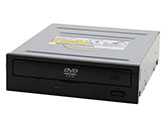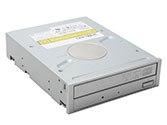Entry Level Buyer’s Guide, July 2005
by Jarred Walton on July 20, 2005 12:05 AM EST- Posted in
- Guides
Storage Recommendations
We've had a couple of articles on the topic of SATA-II recently. The first explained what SATA-II really means, with the basic summary being that it is a "made up" name for 3 Gbps transfer rates and does not require NCQ or any other special features relative to the original SATA. The second was a roundup of SATA-II drives, pitting them against older SATA models. The conclusion of the article was that SATA-II helped in some areas, but there was no decisive winner among the contenders. We invite you to read the article if you want more details, but here, we're basically interested in the best feature level for the best price, with performance being a case of "win some, lose some" regardless of which drive you choose.Budget Hard Drive Recommendation: Hitachi Deskstar 7K80 HDS728080PLA380 80GB SATA-2
Price: $57 shipped (OEM)
Even though SATA-2 is an unofficial spec and doesn't guarantee faster performance, it does win out in several benchmarks and the Hitachi drive is cheaper than any other 80GB SATA HDD. The Hitachi SATA-2 drives also offer NCQ support, though again that can help or hurt performance depending on the application. While some people will want more than the 80GB offered here, most budget users will find the storage to be more than sufficient. If you eventually run out, adding a second hard drive is one of the easiest upgrades that you can make to a PC. Worth mentioning is that not all of the motherboards actually support the faster 3 Gbps transfer rate of SATA-2, but the drives are backwards compatible with 1.5 Gbps data rates, so it's still safe to purchase the newer models, regardless of motherboard.
Upgraded Hard Drive Recommendation: Hitachi Deskstar T7K250 HDT722516DLA380 160GBSATA-2
Price: $87 shipped (OEM)
For our upgraded hard drive, we felt that double the capacity was sufficient. You can get a slightly better cost per GB of storage by moving to the 250GB drives, but few people need that much storage. As with our base recommendation, we ended up settling on the SATA-2 drive from Hitachi. Western Digital makes a standard SATA model that costs $2 less, and Samsung and Seagate have models that are $5 to $10 more, but for now, we're content to go with SATA-2 support at a lower price than competitors offer.
If you want a quieter drive, Samsung is the best choice; the rest of the manufacturers are all pretty similar in noise levels. The best price per GB of storage comes from the Seagate 7200.8 - at least at the time of writing. $119 for 250GB of storage finally breaks the 50 cents per GB mark for SATA storage. Western Digital and Hitachi offer similarly priced models, and the difference between the 160GB Hitachi at 55 cents per GB and the 250GB Seagate at 48 cents per GB may not be enough to get you to fork out the extra $30.
Budget Optical Recommendation: Lite -On 16X DVD-ROM Model SOHD-16P9S
Price: $22 shipped (OEM)
A few people wondered why we would put a DVD+R into a budget system in the last Budget Guide, and the answer is that you really don't need DVD+R/CD-RW capabilities for a budget system. We're saving over $20 by going with a DVD-ROM on our budget setup, but if you have any interest in burning CDs or DVDs, we highly recommend the upgrade to a DVD+R drive. Anyone who doesn't need recording capabilities can get the cheapest DVD-ROM that they can find, but we're requiring DVD support as we've heard that Windows Longhorn will ship on a DVD rather than multiple CDs. The $10 saved by dropping to a CD-ROM isn't worth the hassle of upgrading to DVD support in the future.
Upgraded Optical Recommendation: NEC 16X Silver DVD+/-RW Model ND-3540A
Price: $48 shipped (OEM)
For the rest of you who agree that the backup/archival uses of DVD+R media alone is worth the price of admission, we have the NEC 3540A burner. An update to the 3520A and 3500A, the price of the NEC burners continues to lead all contenders (though by a slim margin). Our recent DVD+R Roundup uncovered issues with reading and writing several types of media with the latest drives, but we're hopeful that BIOS/firmware updates will solve most of the issues. None of the drives were able to obtain a clear victory, and availability of some of the drives (like the BenQ DW1640) is limited. If you can find the BenQ DW1640, it was the only drive that successfully read back every disc that it wrote - though it still couldn't write to every disc type. As another alternative to the NEC drive, the LG GSA-4163 adds DVD-RAM support for a small price increase of $4. Whichever DVD+R you choose, the key is to recognize its strengths and weaknesses in terms of media - paired with the appropriate DVD+/-R, any of these drives will work well.
Optional Equipment: Any 3.5" Floppy Drive
Price: $8 shipped (OEM)
While not required, there are still times when a floppy drive can prove useful. None of these boards will require a floppy to install Windows XP, but if you want to add a second hard drive for RAID support, it will be necessary to have a floppy drive. We haven't verified whether or not the motherboards have Windows flashing utilities for updating the BIOS, but Award BIOSes can be updated using the WinFlash application, and that's the most common BIOS type. We'd almost recommend that you avoid the floppy just so that we can hasten its retirement, but the decision is yours.













57 Comments
View All Comments
bob661 - Wednesday, July 20, 2005 - link
Thanks Jarred.JarredWalton - Wednesday, July 20, 2005 - link
#15 - Bob,OCZ has quite a few overlapping RAM offerings these days, all of which have a place. I recommended the BH5 based Gold that runs 2-2-2-5 1T at 2.8V as opposed to the VX offering that requires 3.2V for 2-2-2-5 1T. Here's the link:
http://www.ocztechnology.com/products/memory/ocz_e...
You can also find the RAM at Newegg:
http://www.newegg.com/Product/Product.asp?Item=N82...
The VX is about the same price, but it doesn't have "Gold" in the name.
----------
WRT the displays, I would much rather have a larger display. Getting people to go from $600 for the basic setup to $750 for a 19" LCD is a tough sell, unfortunately. I really like 19" LCDs (and I like my 2405FPW even more), but few people are willing to shell out over $300 for "just the display". As Hacp mentions, a lot of people just don't realize what they're missing. I know plenty of people with 17" to 19" displays that still run them at 1024x768 - even on LCDs. They just don't realize that resolution is something most people should adjust.
SDA - Wednesday, July 20, 2005 - link
#31, I'm not sure where to start with you.First: Anyone can see the difference between 17" and 19".
Second: You won't notice any difference between a fast system and a (reasonably) slow system when watching movies, writing letters, or surf the web. otoh, you WILL notice a difference between a good monitor and a bad monitor when playing games and editing photos. You're using your monitor every time you're at your computer, but most of the time you don't need a fast CPU at all.
Third: Image quality is important. If image quality wasn't important, people wouldn't buy high-end video cards for games.
IME, people who place I/O equipment (monitor, mouse, sound setup, etc.) at the bottom of the list do so because they have never used genuinely good I/O equipment for any reasonable length of time. I don't mean any offense here, this is just what I've seen.
Zebo - Wednesday, July 20, 2005 - link
sprockkets - just the opposite.. prescott uses about 30% more power than a northwood at same hurtz.. and really starts leaking like crazy after 3.4 which a northwood never saw.Zebo - Wednesday, July 20, 2005 - link
Bob - http://forums.anandtech.com/messageview.aspx?catid...Hacp - Wednesday, July 20, 2005 - link
I doubt that a budgetminded person would recognize the difference between 19 and 17 inches much. Heck, I would even go for a 15 inch LCD if it gave room to get a better video card/cpu or more ram. Screen size is the last thing I think about when I budget for a comptuer.Wellsoul2 - Wednesday, July 20, 2005 - link
The Polywell LCD is a good one but I would go witha 19 inch monitor for around 40 to 50 bucks more.
The bigger LCD makes such a huge difference IMHO
compared to the bang for the buck you get putting
50 bucks anywhere else.
Hacp - Wednesday, July 20, 2005 - link
Btw nice guide. Didn't mention this before.sprockkets - Wednesday, July 20, 2005 - link
Yeah, but consider first that having a prescott core as opposed to a northwood core would save power, but also save more energy also since you don't have to spend money on the HVAC removing the excessive heat it makes too, and that system takes a lot of energy!At work, we have 2.8ghz stupid dell optiplex systems that have no ventilation slots whatsoever, and it is so funny to see all the dust collect on the back and the floppy drive because that is all it can intake from. But they don't put out much heat. However, the newer prescott based ones (same 2.8ghz) are much hotter; in fact, I managed to get prime95 on it, and the stupid computer had to turn on the processor fan to full blast, making it sound like a vacuum cleaner! It even speeds up when loading simple websites (gets louder while loading, then quiets down once the page loaded up)!
Btw, someone at newegg made this comment about not having cool and quiet on semprons: They don't need it! The 2600 and 2800+ (well, at least the 90nm Palermo cores) put out so little heat, I don't even think the fan is necessary! It runs 2-3 degrees over ambient, and around 5 when prime95 is running!
Other note about power supplies and Dell: Dell used to use Delta, then of course the fiance department cut that out and now they use crappy HIPoint. Again, where I work, with new 3.06 ghz systems, out of 30 some systems, nearly all have had the power supply replaced, and a good amount even twice. For exaple, do a search for Dell 4600 and see what I mean. It doesn't pay in the long run to use crappy power supplies for all the issues it causes.
siliconthoughts - Wednesday, July 20, 2005 - link
While I like to build systems as much as the next guy, for a $600 system the new HP A1130n systems (at bestbuy/circuitcity/etc) are really hard to beat (3500+ athlon64 socket 939, 250GB SATA, PCIe, DVD, DVD-RW, integrated ATI X300, 1GB RAM) for ~$650 (w/ monitor and throwaway printer after rebate) Dell has nothing competitive with it.You generally don't build a system like this for yourself anyway - vendors have a purpose: keeping me from being the free-support guy.